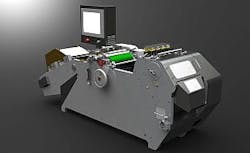Inspection system prints and verifies drug tablets
Engineers atAckley Machine Corp. (Moorestown, NJ, USA) have developed a tablet printing machine based around Cognex (Natick, MA, USA) In-Sight vision systems that not only prints identification marks on tablets but also inspects them to ensure their integrity.
After printing the tablets, the machine drops them into the pockets of a carrier bar that holds up to 24 tablets. This then moves under an array of four Cognex In-Sight vision systems where each camera inspects six tablets. Vision system software then uses ahistogram tool to check for the presence of the light-colored tablet against the dark background of the carrier bar. If a tablet is present, then the vision system performs a print quality check.
A PatMaxpattern-recognition algorithm looks for a printed image, after which it identifies and isolates the key individual features within it and measures characteristics such as shape, dimensions, angle, arcs, and shading. The algorithm correlates the spatial relationships between the key features of a trained image to the run-time image, encompassing both distance and relative angle. By analyzing the geometric information from both the features and spatial relationships, the object’s position can be determined without regard to the object’s angle, size, or appearance.
The algorithm compares a good image to the most recently acquired image and rates the quality of the recently acquired image based on this match. The PatMax algorithm also returns the location of the printing’s center to determine how well the logo is centered on the tablet.
Next, the tablet is checked to see if it is broken. A broken tablet shows up as several light-colored sections against a dark background. A blob tool looks for light-colored blobs that are smaller than the tablet. The final step is to look for a coating defect, which can be identified as a smaller white spot.
The inspection results for each of the six tablets are then sent to a programmable logic controller (PLC) that controls a vacuum system, which picks up the tablets that have passed the inspection and places them in a discharge chute, while those that have failed remain in the carrier bar and are dumped into a reject bin.
The integrated vision system enables the machine to inspect more than 400,000 tablets per hour. According to the company, the system is unique in that it can reject individual tablets while other machines on the market can only reject batches.
-- Posted byVision Systems Design
